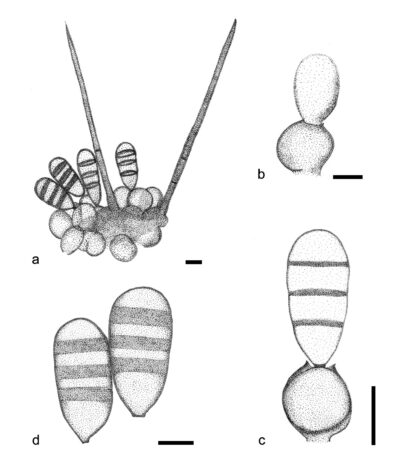Fungalpedia – Note 290, Adautomilanezia
Adautomilanezia Gusmão, S.S. Silva, Fiúza, L.A. Costa & T.A.B. Santos
Citation when using this entry: Perera et al. 2024 (in prep) – Fungalpedia, genera described in 2016.
Index Fungorum, Facesoffungi, MycoBank, GenBank, Fig. 1
Classification: Chaetosphaeriaceae, Chaetosphaeriales, Sordariomycetidae, Sordariomycetes, Pezizomycotina, Ascomycota, Fungi
Crous et al. (2016) established this monotypic, hyphomycetous genus to accommodate Adautomilanezia caesalpiniae, which was isolated form decaying twigs of Caesalpina echinate (Crous et al. 2016). Phylogenetic analysis based on LSU marker placed Adautomilanezia in Chaetosphaeriaceae (Crous et al. 2016). The genus is characterized by producing black, astromatic and effuse colonies and, sporodochial conidiomata on natural substrate. Sporodochia are black, determinate and, occur solitary or in groups. Dark brown to black setae are arising intermixed with conidiogenous cells. They are straight to curved, smooth-walled and septate with an acute apex and an inflated base. Conidiophores are reduced to conidiogenous cells. Conidiogenous cells are enteroblastic, unilocal and arising from superficial hyphae with lacerate conidiogenous loci. They are pale brown, globose to subglobose, clustered, sessile, and have thick walls. Conidial secession is schizolytic and produced exogenously. Conidia have smooth walls, are solitary, dry, oblong to clavate, and multiseptate. Their colour ranges from pale brown to brown. The sexual morph remains undetermined (Crous et al. 2016).
Type species: Adautomilanezia caesalpiniae Gusmão, S.S. Silva, Fiuza, L.A. Costa & T.A.B. Santos
Other accepted species: This genus is monotypic.
Figure 1 – Adautomilanezia caesalpiniae (HUEFS216632, holotype). a Conidiogenous cells, conidia and setae. b, c Conidial development. d Mature conidia. Scale bars: a–d = 10 μm. Redrawn from Crous et al. (2016).
Reference
Entry by
Rekhani Hansika Perera, Center of Excellence in Fungal Research, Mae Fah Luang University, Chiang Rai, 57100, Thailand.
(Edited by Kevin D. Hyde, Samaneh Chaharmiri-Dokhaharani, & Achala R. Rathnayaka))
Published online 8 July 2024
